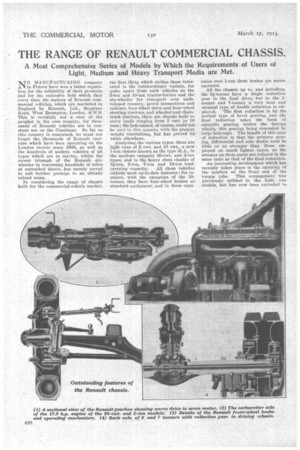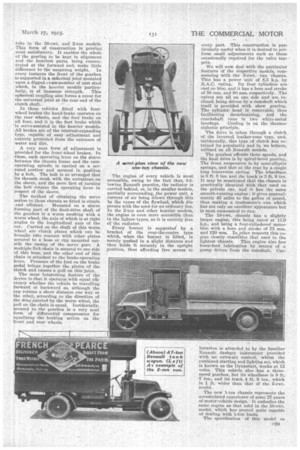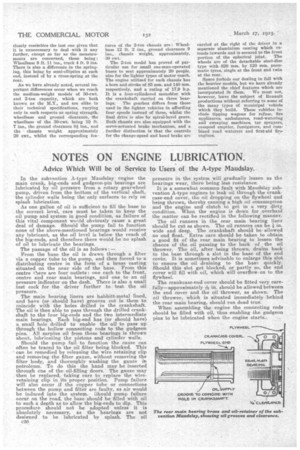THE RANGE OF RENAULT COMMERCIAL CHASSIS.
Page 12

Page 13

Page 14

If you've noticed an error in this article please click here to report it so we can fix it.
A Most Comprehensive Series of Models by Which the Requirements of Users of Light, Medium and Heavy Transport Media are Met.
NO MANUFACTURING company in France have won a better reputation for the reliability of their products and for the extensive field which they
• cover than the makers of Renault commercial vehicles, which are marketed in England by Renault, Ltd., Seagrave • Road, West Brampton, London, S.W.& This is certainly not a case of the prophet in his own country, for thousands of Renault vehicles are in constant use on the Continent. So far as this country is concerned, we must not forget the thousands of Renault taxicabs which have been operating on the London streets since 1906, as well as the hundreds of modern vehicles of all types which are in service, whilst the recent triumph of the Renault sixwheeler in traversing hundreds of miles of untracked desert, has merely served to add further prestige to an already valued name.
In considering the range of chassis built for the commercial-vehicle market,
the first thing which strikes those interested is the extraordinary variety, for quite apart from such vehicles as the 5-ton and 10-ton tractor-lorries and the six-wheeler for transport over uncle: veloped country, petrol locomotives and railears, four-wheel drive and four-wheel steering tractors, and wheeled and chaintrack tractors, there are chassis built to carry loads ranging from 5 cwt. to 10 tons ; the last-named, of course, could not be used in this eountry, with the present weight restrictions, but has proved its .value elsewhere. Analysing the various types,..thereare light vans of 5. cwt. and 10 cwt., a new 1-ton. chassis known as the type MA., in the medium category 30-cwt. and.2-ton types, and in the heavy class chagsis of 3i-ton, 5-ton, .7-ton and 10-ton loadcarrying capacity. " All these vehicles embody most up-to-date features ; for instance, with the exception of the 10tonner, they have four-wheel brakes as standard equipment, and in those capa
cities over 1-ton these brakes are servooperated.
All the chassis up to, and including, the 3i-tonner have a single reduction gear in the final drive, -but in the 5twiner and 7-tonner a very neat and unusual type of double reduction is employed. The first reduction is by the normal type of bevel gearing, and the final reduction takes the form of epicyclic gearing within the driving wheels, this gearing being concealed by large hub-caps. The benefit of this type of reduction is that the primary gearing, differential and axle shafts need be little or no stronger than those employed on much lighter types, as the stresses on these parts are reduced in the same ratio as that of the final reduction.
An interesting development which has recently taken placeis the carrying of the gearbox on the front end of the torque tube. This arrangement was previously utilized in the, light van models, but has now been extended to take in the 30-cwt. and 2-ton models. This form of construction is proving most satisfactory. It enables the whole cf the gearing to be kept in alignment and the heaviest parts, being concentrated at the forward end, make little difference to the unsprung weight. In every instance the front of the gearbox is supported in a spherical joint mounted upon a dipped cress-member of cast steel which, in the heavier models particu
larly, is of immense strength. This spherical coupling also forms a cover for the universal joint at the rear end of the clutch shaft.
In those vehicles fitted with fourwheel brakes the hand-brake operates on the rear wheels, and the .foot brake on all four, and it is the foot brake which 'is servo-assisted in the heavier models. All brakes are of the internal-expanding type, capable of easy adjustment and entirely protected from the entrance of water and dirt.
A very neat form of adjustment is provided for the front-wheel brakes. In .these, each operating lever on the sleeve between the chassis frame and the camoperating spindle is carried on a serrated portion and secured in position by a bolt. The bolt is so arranged that its threads mesh with the serrations. on the sleeve, and the mere fact of turning the bolt rotates the operating lever in respect of the sleeve.
The method of obtaining the servo action in those chassis so fitted is simple and efficient. Mounted on a sleeve forming part of the final-drive shaft of the gearbox is a worm meshing with a worm wheel, the axis of which is at right angles to the longitudinal axis of the ear. Carried on the shaft of this worm wheel are clutch plates which can be brought into contact with other plates secured to a boss or cap mounted outside the casing of the servo gear. A multiple link chain is secured to one side of this boss, and the other end of this chain is attached to the brake-operating lever. Pressure of the foot on the brake pedal brings together the plates of the clutch and causes a pull on this joint.
The most interesting feature of the device is that it operateswith equal efficiency whether the vehicle be travelling forward or backward as, although the cap rotates a short distance one way or the other, according to the direction of the drag .exerted by the worm wheel, the pull on the chain is equal. Incidentally, secured to the gearbox is a very neat form of differential compensator for equalizing the braking action on the front and rear wheels. The engine of every vehicle is most accessible, owing to the fact that, following Renault practice, the radiator is carried behind, or, in the smaller models, partially surrounding, the power unit, a current of air being drawn through this by ale vanes of the flywheel, which dispenses with the need for an ordinary fan. In the 2-ton and other heavier models, the engine is even more accessible than in the lighter types, as it is entirely free of the radiator.
Every bonnet is supported by a bracket of the over-the-centre type which, when the bonnet is lifted, is merely pushed in a slight distance and then holds it securely in the upright position, thus affording free access to every part. This construction is particularly useful when it is desired to perform small adjustments such as those occasionally required for the valve tappets.
We will now deal with the particular features of the respective models, commencing with the 5-cwt. van chassis. This has a power unit of 8.3 h.p. by R.A.C. rating. Its four cylinders are cast en bloc, and it has a bore and stroke of 58 mm. and 90 mm. respectively. The valves are all on one side and are inclined, being driven by a Camshaft which itself is provided with skew gearing. The cylinder head is removable, thus facilitating decarbonizing, an'd the crankshaft runs in two white-metal
bearings. Cooling is on the thermosiphonic principle.
The drive is taken through a clutch of the inverted leather-cone type, and, incidentally, this type of clutch has retained its popularity and is, we believe, utilized on all Renault models.
The gearbox affords three speeds, and the final drive is by spiral-bevel gearing. The front suspension is by semi-elliptic springs, and that at the rear by a single ions transverse spring,. The wheelbase is g'ft. 8 ins, and the track is 3 ft. 9 ins. It may be mentioned that the chassis is practically identical with that used on the private car, and it has the same smooth-running engine ; it gives approximately 45 miles to the gallon of petrol, thus making a tradesman's van which has tiot only an excellent appearance but is most economical to run.
The 10-ewt, chassis has a slightly larger engine, this being rated at 13.9 h.p., and being a four-cylindered monobloc with a bore and stroke of 76 mm. and 120 mm. In other respects this engine closely resembles that used in the lightest chassis. This engine also has force-feed lubrication by means of a pump driven from the camshaft. Car bnration is attended to by the familiar Renault dashpot instrument provided with an extra-air control, whilst the combined starting and lighting set, which is known as the Dynastart, works at 12 volts. This vehicle also has a threespeed gearbox, but its wheelbase is 9 ft. 7 ins., and its track .4 ft. 9 ins., which is 1 ft. wider than that of the 5-cwt. model.
The new 1-ton chassis represents the accumulated experience of some 27 years of motor-vehicle design. It embodies the same engine as that used in the 10-cwt. model, which has proved quite capable of dealing with 1-ton loads.
The specification of this model so 029 closely resembles the last one given that it is unnecessary to deal with it any further, except so far as the measurements are concerned, these being : Wheelbase 9 ft. 11 ins., track 4 ft. 9 ins. There is also a difference in the springing, this being by semi-clliptics at each end, instead of by a cross-spring at the rear.
As we have already noted, several important differences occur when we reach the medium-weight models of 30-cwt. and 2-ton capacity, which are both known as the M.Y., and are alike in their technical specifications, varying only in such respects as spring strength, wheelbase and ground Clearance, the wheelbase of the 30-cwt. being 10 ft. 7 ins., the ground clearance 8i ins., and the ' chassis weight approximately 29 cwt., whilst the corresponding Lea
tures of the 2-ton chassis are : Wheelbase 12 ft. 2 ins., ground clearance 9 ins., chassis weight, approximately, 30 cwt.
The 2-ton model has proved of particular use for small one-man-operated buses to seat approximately 20 people, also for the lighter types of motor coach. The engine utilized for each chassis has a bore and stroke of 85 mm. and 140 mm. respectively, and a rating of 17.9 h.p. It is a four-cylindered monobloc with the crankshaft carried on three bearings. The gearbox differs from those used in the lighter vehicles in affording four speeds instead of three, whilst the final drive is also by spiral-bevel gears. Both chassis are also equipped with the servo-actuated brake mechanism, and a further distinction is that the controls for the change-speed and hand brake are
carried at the right of the driver in a separate aluminium casting which extends inwards and is secured to the front
portion of the spherical joint. The wheels are of the detachable steel-disc type with 820 mm. by 120 mm. pneumatic tyres, single at the front and twin at the rear.
Space forbids our dealing in full with the heavier models, but we have already mentioned the chief features which are incorporated iii them. We must not, however, leave the subject of Renault productions without.referring to some of the many types of municipal vehicle which they build. These vehicles include tipping wagons for refuse, fire appliances, ambulances, road-watering and sweeping machines, tar sprayers, cesspool emptier, fumigators, and combined road waterers and first-aid fireengines.
































